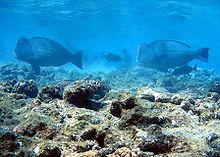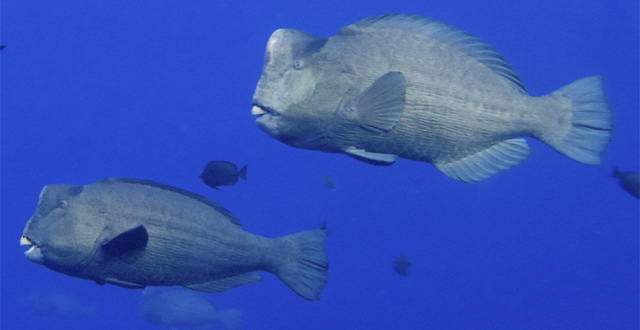Habitat
The
Bolbometopon muricatum, commonly known as the Green Humphead
Parrotfish dwells in the outer edges of coral reefs within the
Pacific, Indian and Atlantic Ocean. Most populations of parrotfish
habitats are commonly found off of Japan, Australia, Mexico, Brazil,
as well as other coastal areas of South America (Kobayashi et al.
2011). These waters tend to be warmer and serve as a place of
protection, as well as feeding and reproductive grounds for the 85
species of Bolbometopon muricatum that inhabit these outer
reefs. Refer to
Classification page for more information. These reefs are usually large and contain many other animals
and organisms (Bellwood et al. 2012). Some of these organisms
include the
Ocellaris Clownfish,
Bull
Shark, and
Moon
Jellyfish. Each level of the sea is very
important to the life of the parrotfish as they live in all three
parts of the sea (deep, middle and shallow). In each region
the parrotfish is exposed to different situations as well as
different organisms, never the less these steps are important as
each location plays a key role in the life cycle of this particular
fish.

The shallow and middle
regions are used primarily for feeding and reproduction. The
algae that the parrot fish consumes live in shallow to middle waters
as the algae needs the light source to reproduce and feed (Min de
Mitcheson et al. 2011). Because the Green Humphead Parrotfish must
come to these light exposed areas, it utilizes a slime mechanism
that covers the scales as they are very susceptible to sun damage.
This mechanism makes it possible for the parrotfish to feed in the
middle region without directly exposing itself to possibly harmful
rays, as the middle region offers exposure to a wider range of
harmful rays than the deep region. As well this protective mechanism
allows the parrotfish to safely dwell in the shallow water (Bellwood
et al. 2012).
The shallow region of the
sea not only contains an abundant food supply, it also provides an
optimal breeding ground for these fish. In comparison with the
deeper regions of the sea, because of its exposure to the sun’s
light, shallow water is warmer. This warmth provides better
conditions for the parrotfish to reproduce. The habitat of the
parrotfish provides the best location for reproduction as there are
often caves and grooves within the ocean floor (Kobayashi et al.
2011). Environmental factors such as caves, and groves are used to
store eggs. Warmer water are necessary for life to occur. If these
fish were unable to swim to shallower depths, the eggs or offspring
wouldn’t survive because of the waters temperature. Refer to
Reproduction page for
more information.
The deeper region is
responsible for overall protection from other predators and
protection from fishermen. Refer to
Interaction page for more details. Parrotfish use the deep sea as a way to
escape predators that need to stay in warm water to survive (Min de
Mitcheson et al. 2011). By going into the deeper water the
Bolbometopon muricatum hide in underwater caves blending into the
dark crevasse using their camouflage like scales. The colors they
reflect resemble their surrounding but also reflect their location
around the world. This makes each parrotfish unique and their use of
each region of the sea different from one another.
To navigate to our home page simply press
Home located on the bottom of every page, or continue to the
Form and Function page.
